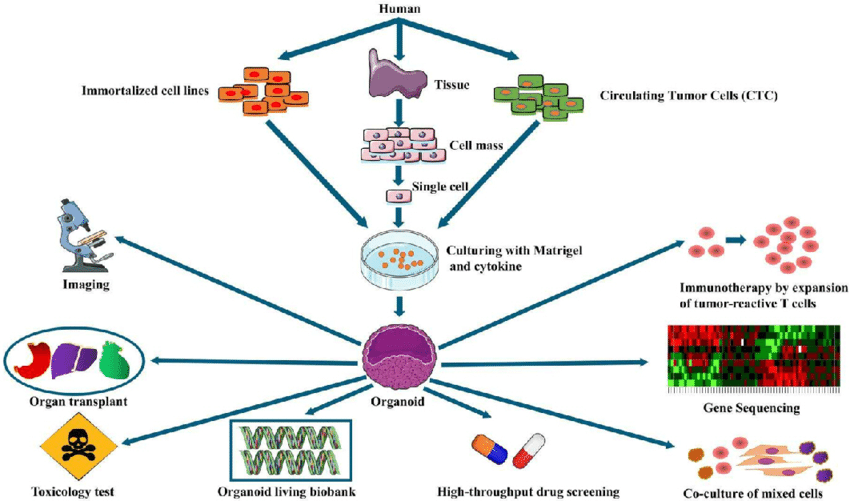
Applications of organoids in biomedical research
Organoids are miniaturized tissue cultures that are derived from stem cells or tissue-specific progenitor cells. Organoids have made it possible to create individual, complex, and self-organizing 3D tissue cultures bearing a resemblance to a patient’s own organ or tissue. This article highlights the applications of organoids in disease modeling, developmental studies, and drug discovery in biomedical research.
1. Organoids and personalized medicine
Organoids are an important tool in developing personalized medicine as they can be generated using cells derived from patient biopsies. Direct testing of drugs and therapies on organoids increases the odds of prescribing efficient treatments to patients. For instance, mutations in the gene cystic fibrosis transmembrane conductance regulator (CFTR) affect CFTR protein production which further causes cystic fibrosis.
CFTR modulators modify the defective protein in patients but the treatment response in every patient varies. Jacquelien Noordhoek and her team were successful in developing a CFTR-dependent assay using primary stem cell-derived organoids that can measure how efficient CFTR modulators are in preclinical experiments. Drug responses in these intestinal organoids reflected drug responses in vivo (1).
2. Organoids and regenerative medicine
Organoids are able to mimic genetic and physiological features of tissues and organs and that helps in understanding disease pathology. Thus, because of these reasons, they pave the way to understanding tissue development, differentiation, and ECM interactions. Intestinal organoids are successfully being employed to study human inflammatory bowel disease with the aim to develop a standardized procedure to restore intestinal epithelial function. Studies have shown that intestinal organoids can also be transplanted back into the body to undergo further functional maturation (2).
3. Organoids and cancer
The development of anti-cancer treatments has been slow and limited because of the lack of accurate in vitro models with high efficiency in predicting clinical outcomes. Organoid systems are currently being used for modeling cancer development and treatments. In 2017, Laura Broutier developed human primary liver cancer-derived organoid cultures and was successful in preserving the histological architecture and genetic features of the original tumor. Such models are crucial to understanding liver cancer biology and develop personalized medicines (3).
References
1. Noordhoek J, Gulmans V, van der Ent K, Beekman JM. Intestinal organoids and personalized medicine in cystic fibrosis: a successful patient-oriented research collaboration. Curr Opin Pulm Med. 2016 Nov;22(6):610-6. doi: 10.1097/MCP.0000000000000315. PMID: 27635627.
2. Nakamura T, Sato T. Advancing Intestinal Organoid Technology Toward Regenerative Medicine. Cell Mol Gastroenterol Hepatol. 2017 Nov 2;5(1):51-60. doi: 10.1016/j.jcmgh.2017.10.006. PMID: 29204508; PMCID: PMC5704126.
3. Broutier L, Mastrogiovanni G, Verstegen MM, Francies HE, Gavarró LM, Bradshaw CR, Allen GE, Arnes-Benito R, Sidorova O, Gaspersz MP, Georgakopoulos N, Koo BK, Dietmann S, Davies SE, Praseedom RK, Lieshout R, IJzermans JNM, Wigmore SJ, Saeb-Parsy K, Garnett MJ, van der Laan LJ, Huch M. Human primary liver cancer-derived organoid cultures for disease modeling and drug screening. Nat Med. 2017 Dec;23(12):1424-1435. doi: 10.1038/nm.4438. Epub 2017 Nov 13. PMID: 29131160; PMCID: PMC5722201.



